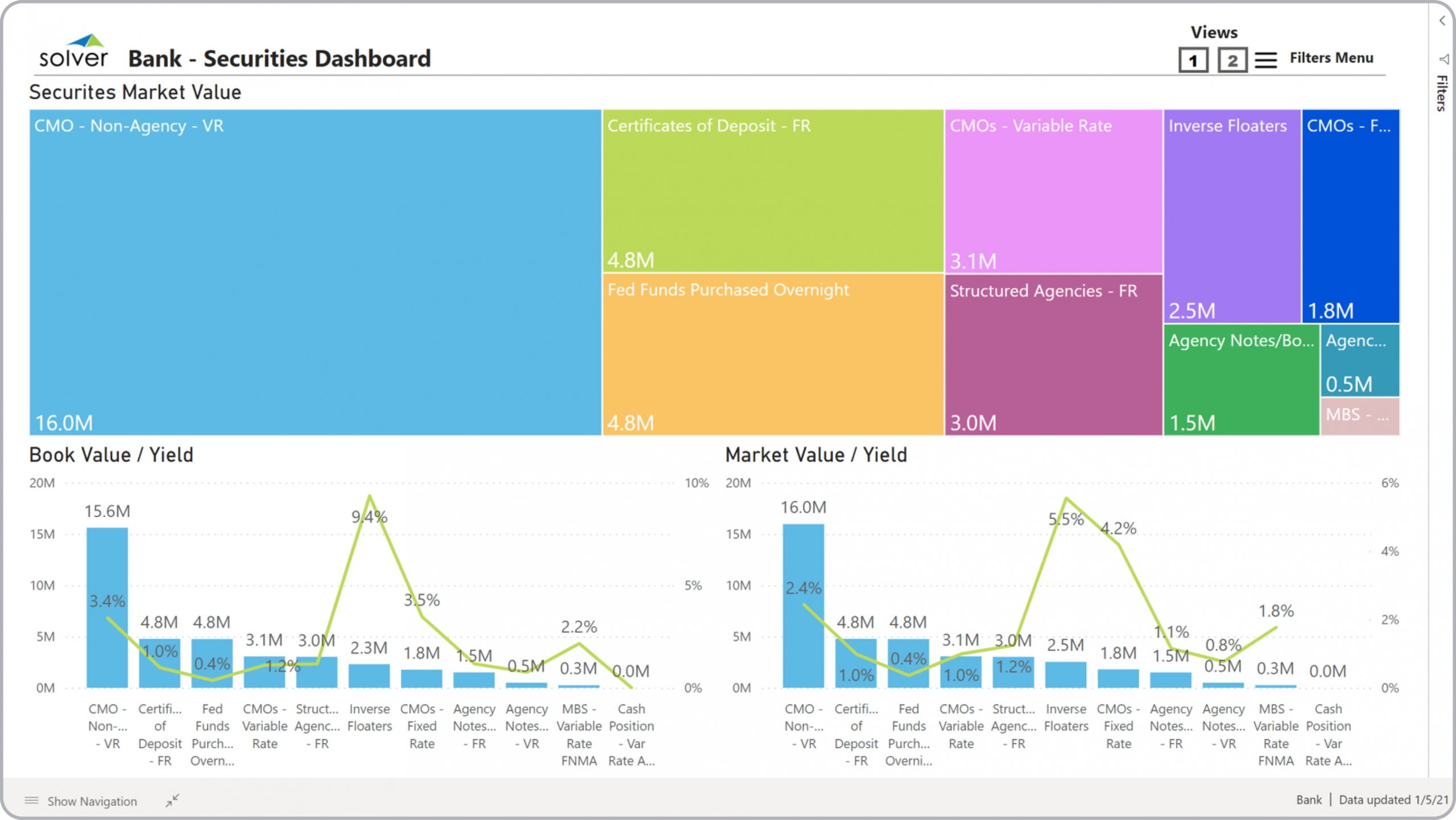Securities Dashboard for Banks
What is a
Securities Dashboard for Banks
? Securities Dashboards are considered financial instrument analysis tools and are used by executives and financial managers to analyze key metrics for the bank's financial instruments. Some of the main functionality in this type of dashboard is that it track performance metrics from three different perspectives, including: 1) Tree map showing market value for the banks securities, 2) Ranked comparisons of book value and yield per financial instrument, and 3) Ranked comparisons of book value and yield per instrument. You find an example of this type of dashboard below.
Purpose of
Securities Dashboards Banks use Securities Dashboards to give leaders and analysts a single screen to quickly see values and yields related to their financial instruments. When used as part of good business practices in Financial Planning & Analysis (FP&A) departments, a company can improve its decision-making and increase profitability, and it can reduce the chances that leaders miss important trends and KPI statuses.
Example of a
Securities Dashboard Here is an example of a Securities Dashboard with KPIs for market values, book values and yields. [caption id="" align="alignnone" width="2560"]
 Example of a Securities Dashboard for Banks[/caption] You can find hundreds of additional examples
here
Who Uses This Type of
Dashboard
? The typical users of this type of dashboard are: Executives, CFOs, analysts, securities managers, investment managers.
Other Reports Often Used in Conjunction with
Securities Dashboards Progressive Financial Planning & Analysis (FP&A) departments sometimes use several different Securities Dashboards, along with detailed securities dashboards, securities reports, investment reports, financial statements, forecasts and other management and control tools.
Where Does the Data for Analysis Originate From? The Actual (historical transactions) data typically comes from financial investment systems and enterprise resource planning (ERP) systems like: Microsoft Dynamics 365 (D365) Finance, Microsoft Dynamics 365 Business Central (D365 BC), Microsoft Dynamics AX, Microsoft Dynamics NAV, Microsoft Dynamics GP, Microsoft Dynamics SL, Sage Intacct, Sage 100, Sage 300, Sage 500, Sage X3, SAP Business One, SAP ByDesign, Acumatica, Netsuite and others. In analyses where budgets or forecasts are used, the planning data most often originates from in-house Excel spreadsheet models or from professional corporate performance management (CPM/EPM) solutions.
What Tools are Typically used for Reporting, Planning and Dashboards? Examples of business software used with the data and ERPs mentioned above are:
Example of a Securities Dashboard for Banks[/caption] You can find hundreds of additional examples
here
Who Uses This Type of
Dashboard
? The typical users of this type of dashboard are: Executives, CFOs, analysts, securities managers, investment managers.
Other Reports Often Used in Conjunction with
Securities Dashboards Progressive Financial Planning & Analysis (FP&A) departments sometimes use several different Securities Dashboards, along with detailed securities dashboards, securities reports, investment reports, financial statements, forecasts and other management and control tools.
Where Does the Data for Analysis Originate From? The Actual (historical transactions) data typically comes from financial investment systems and enterprise resource planning (ERP) systems like: Microsoft Dynamics 365 (D365) Finance, Microsoft Dynamics 365 Business Central (D365 BC), Microsoft Dynamics AX, Microsoft Dynamics NAV, Microsoft Dynamics GP, Microsoft Dynamics SL, Sage Intacct, Sage 100, Sage 300, Sage 500, Sage X3, SAP Business One, SAP ByDesign, Acumatica, Netsuite and others. In analyses where budgets or forecasts are used, the planning data most often originates from in-house Excel spreadsheet models or from professional corporate performance management (CPM/EPM) solutions.
What Tools are Typically used for Reporting, Planning and Dashboards? Examples of business software used with the data and ERPs mentioned above are:
- Native ERP report writers and query tools
- Spreadsheets (for example Microsoft Excel)
- Corporate Performance Management (CPM) tools (for example Solver)
- Dashboards (for example Microsoft Power BI and Tableau)
Corporate Performance Management (CPM) Cloud Solutions and More Examples
May 26, 2021
TAGS:
Reporting,
Solver,
bank dashboard,
report writer,
Microsoft,
template,
practice,
Acumatica,
Netsuite,
Finance,
planning,
GP,
dashboard,
Business Central,
excel,
ax,
market value,
securities,
forecast,
Budget,
Dynamics 365,
analysis,
budgeting,
KPI,
bank,
Cloud,
Software,
Tableau,
SAP,
example,
best,
book value,
Sage,
BC,
D365,
NAV,
Intacct,
CPM,
report,
SL,
Management,
dynamics,
Power BI,
securities dashboard

